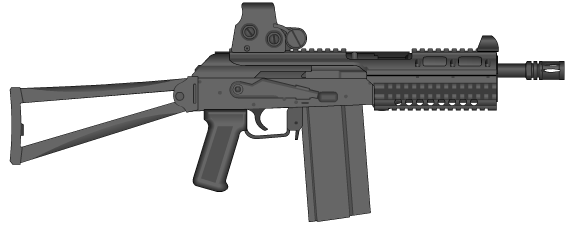Haulis 12
| Haulis 12 | |
|---|---|
 | |
| Type | Semi-automatic shotgun |
| Place of origin | Astronea |
| Service history | |
| In service | 1994-present |
| Used by | Astronean Armed Forces |
| Production history | |
| Designed | 1992 |
| Manufacturer | Haulis Defensive Solutions |
| Unit cost | $500 |
| Produced | 1992-present |
| Specifications | |
| Length | 910 mm (36 in) |
| Barrel length | 430 mm (17 in) |
| Width | 31 mm (1.2 in) |
| Height | 135 mm (5.3 in) |
| Cartridge | 12-Gauge |
| Action | Gas-operated, rotating bolt |
| Rate of fire | Semi-automatic |
| Muzzle velocity | 365 m/s (1,200 ft/s) |
| Effective firing range | 50 m (55 yd) |
| Maximum firing range | 70 m (77 yd) |
| Feed system | 5, 10 round detachable box magazine, 20 round detachable drum magazine |
| Sights | Front blade, rear square notch (removable) |
| References | |
A semi automatic shotgun designed for close encounters, the Haulis 12 is based on a heavily modified AM-64 frame. Magazine fed, with a folding skeletal stock, shortened barrel, breacher choke and full RIS for mounting optics and illumination devices. The ultimate breaching tool, the Haulis was specifically designed with police and counter terrorism units in mind. As such, the weapon has a number of features well suited for urban environments. Its shortened barrel and small profile allow it to be transported in vehicles with ease, especially when the stock is folded . The Haulis may be equipped with 5, 10 or 20 round magazines for additional firepower.
The manufacturing of the Haulis is incredibly simple, following the same base design as the already existing AM-64 and AM-96 upgrades. This reduces the overall cost of the shotgun significantly. If an operator is familiar with the AM-64 system or its derivatives, operating the Haulis is straightforward and shooting is fundamentally similar to its rifle caliber cousins.
Design
To accommodate for the larger size of shotgun shells, the extraction port of the Haulis was increased in size significantly. However, to be able to use the AM-64 bolt, the rear section of the bolt is covered by a sliding metal flap that rides on the recoil spring. This allows the gun to be sealed against dirt when the bolt is forward, but the compression of the recoil spring during firing moves the flap rearward to clear the extracted shells. The extractor on the Haulis does not rotate, but instead delegates the bolt-locking function to a caliber-neutral lug directly behind the bolt-face.
The modified internals also incorporate an adjustable two-position gas system, for the reason that firing high power loads such as slugs and buckshot generates so much force that the receiver will be damaged if the full power of the gas system is employed without some sort of recoil buffer. The problem is that making the gun durable with the higher power loads would make it useless with low-power loads such as bean-bags and flares since the gun would fail to cycle – becoming in essence a manual straight-pull action or producing a "stovepipe" malfunction.
The magazine style has also been altered, changed to a vertical-insertion as opposed to the traditional rock-in style used previously on the AM series of rifle. His allows for easier and faster reloading, requiring only a single hand. The Haulis also features a last round bolt hold-open system, in which the bolt will lock open after the last round of the magazine has been fired, indicating to the user that the weapon is empty. Modifications were made to the trigger group, bolt, and bolt carrier that allows loaded magazine insertion without locking the bolt back.
Service history
The Astronean Armed Forces, as well as police units within Astronea, use the Haulis 12 for close-combat, crowd control, dynamic breaching and perimeter defence. It is considered reliable and effective, as well as adaptible. The Astronean Special Forces unit "Asymmetric Warfare Detachment" is reported to field the weapon for hostage rescue missions, as seen in a high profile raid against terrorist elements who laid siege to Feldrum City Library in 2009. It has also seen use abroad by various foreign military and police units.